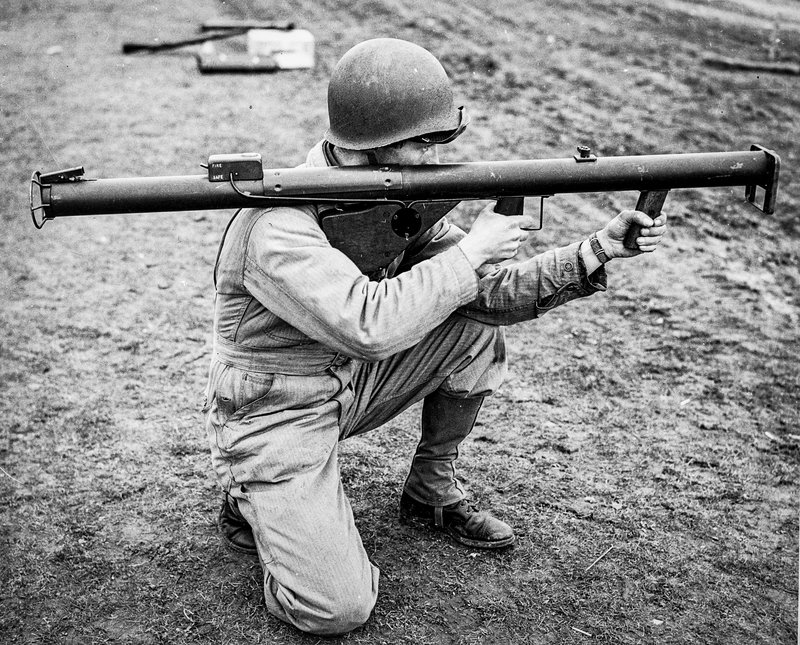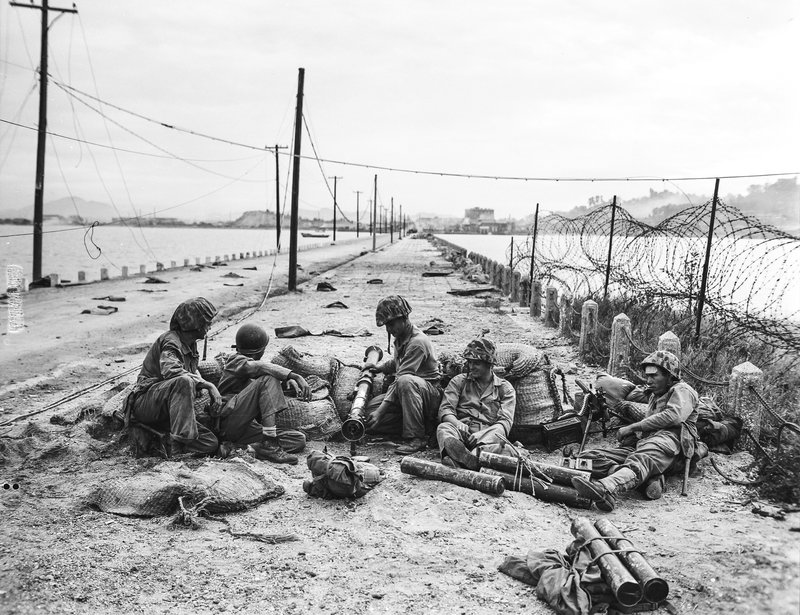
Members of the US Army’s 24th Infantry Division were the first United States ground units to reach the front and go into action against North Korean forces at the village of Sojong-Ni, near Osan. Here a team uses a Bazooka during the Battle of Osan. Wikimedia Commons photo.
By the fall of 1944, Maj. Charles Carpenter had grown fed up with flying his unarmed Piper L-4 Grasshopper observation plane. Though critical, his low-flying missions to spot German troop movements in advance of Gen. George S. Patton’s 4th Armored Division were extremely dangerous. Determined not to suffer the same fate as the 49 aircraft of Gen. Omar Bradley’s 1st Army that had already been shot down during the push through France, Carpenter decided to go on the offensive.
As a reconnaissance pilot, Carpenter lacked means of defending himself if targeted by anti-aircraft weapons on the ground. So he decided to transform his surveillance aircraft into a war machine using the tools and equipment available to him. He bolted six M1 “bazooka” rocket launchers on the wing struts of his plane. The firing mechanisms on the bazookas were wired to a trigger in the cockpit.

Maj. Charles Carpenter earned the nickname "Bazooka Charlie" for attaching bazookas to his observation plane during World War II. US Army photo.
Now armed to the teeth, Carpenter took to the skies over France, swooping down on German Panzer columns and blowing up tanks with his bazookas. Sometimes he’d land at a nearby airfield, reload, and then resume his attack. On one occasion, German tanks pinned down a group of American infantrymen in a creek bed. Carpenter arrived over their position and made several passes, firing 16 bazookas and destroying two tanks.
Carpenter gained so much notoriety as a tank-buster that newspapers began reporting on his exploits. The Associated Press nicknamed him “Bazooka Charlie” and also called him a “tank ace,” a title achieved by destroying five enemy tanks.
“Some people think I’m nuts,” Carpenter informed the United Press in October 1944, “but I just believe that if we’re going to fight a war, we have to go on with it at 60 minutes an hour and 24 hours a day.”
Related: The M4 Sherman: The Tank That Won World War II
Why Is It Called a Bazooka?

A soldier holding a M1 Bazooka while serving during World War II. Wikimedia Commons photo.
In 1918, Sgt. Robbie “Bob” Burns sailed to France as a member of the US Marine Corps’ 11th Regiment. The unit was originally formed as a light artillery regiment but was reflagged as infantry in anticipation of frontline trench warfare.
Burns and the other Marines of the 11th Regiment did not see combat, however. In fact, instead of fighting in the trenches, Burns became the leader of the Marine Corps jazz band, known as the Melody Six. The band toured Europe in the waning days of World War I.
In September 1919, upon their return home from Europe, the Melody Six were the subject of a newspaper article published in The Evening World. The article stated that according “to tales told by the Marines, the Melody Six are the snappiest, zippiest, jazziest aggregation of tune artists in any branch of Uncle Sam’s service.”
The article also noted the odd musical instrument invented and played by Burns, a creation he called the “Bazooka,” which he had crafted using two gas pipes — one tin funnel, and a little axle grease. The instrument was classified as an aerophone because it relied on lip movements to produce sounds.

Marines Pfc. Lauren N. Kahn, left, and Pfc. Lewis M. Nalder display a bazooka that knocked out four Japanese light tanks. Wikimedia Commons photo.
After the Marine Corps, Burns went on to achieve fame as a radio comedian. He hosted the “Bob Burns Show” through the 1940s and popularized the Bazooka.
Meanwhile, the US military was busy developing a new weapon to destroy tanks. In the early days of World War II, German armor in North Africa proved too formidable for the Army’s rifle grenades.
Col. Leslie Skinner, a US Army rocket engineer, took a concept first envisioned at the end of WWI to develop a tube-fired rocket that could fire a grenade-like explosive at a target from a safe distance. He tasked his underling, Lt. Ed Uhl, with developing the technology.
“I was walking by this scrap pile, and there was a tube that […] happened to be the same size as the grenade that we were turning into a rocket,” Uhl would later recall. “Put the tube on a soldier’s shoulder with the rocket inside, and away it goes.”
In 1942, while testing Uhl’s prototype at the Army’s Aberdeen Proving Grounds in Maryland, someone remarked that it looked “like Bob Burns’ bazooka.” The name stuck, and the M1 “Bazooka” would soon be fielded to American troops in World War II.
Related: When Bullets Just Won’t Cut It, Grab a Grenade Launcher
The Bazooka in Combat

Marines from the 1st Marine Division using bazookas to protect a machine gun set up a security post against possible tank counterattack. Wikimedia Commons photo.
The Bazooka was used in the North African, European, and Pacific theaters of WWII. As a result of the weapon’s ubiquity, Maj. Carpenter wasn’t the only American GI to receive the “Bazooka Charlie” nickname.
Pfc. Charles “Bazooka Charlie” Oliver of Texas served in the US Army alongside the Marine’s 38th Division in the Philippines. According to an article published in the San Angelo Evening Standard in May 1945, Oliver fired 25 bazooka rounds at Japanese positions while advancing toward the Marikina River’s Wawa dam in Luzon, missing only twice.
The Germans also developed their own version of the Bazooka. The Panzerschreck, or “tank terror,” had an effective range of 150 to 180 meters and was operated by a two-person crew — a gunner and a loader.

A paratrooper clasps his bazooka before take-off for the initial assault of D-Day. Wikimedia Commons photo.
Like many American weapons developed in the 20th century, the Bazooka saw action in more than one war. It was fielded in Korea but ultimately proved ineffective against Russian-supplied T-34 tanks because its warhead couldn’t penetrate the armor. Fortunately, by that point, the US Army was already developing the M20 “Super Bazooka.”
George Eaton, a US Army historian, discussed why the Super Bazooka was superior to its predecessor on a television special called Arsenal History that aired in 2015.
“Its improved warhead could penetrate double the armor of the World War II model,” Eaton said. “It was easier to handle in the field due to its two-piece assembly and the improved site improved accuracy and range.”
The Super Bazooka’s 88.9mm warhead could pierce 11 inches of armor, which justified its usage against the T-34s. However, according to the National Army Museum in Britain, the Super Bazookas were primarily used as artillery weapons against foot soldiers after the Chinese started pumping manpower into the war. The Super Bazooka remained in service through the early stages of the Vietnam War and was then replaced by the M72 LAW rocket launcher.
Read Next: Why the ‘Commando’ Quad-Tube Rocket Launcher Replaced the Flamethrower

Matt Fratus is a history staff writer for Coffee or Die. He prides himself on uncovering the most fascinating tales of history by sharing them through any means of engaging storytelling. He writes for his micro-blog @LateNightHistory on Instagram, where he shares the story behind the image. He is also the host of the Late Night History podcast. When not writing about history, Matt enjoys volunteering for One More Wave and rooting for Boston sports teams.
BRCC and Bad Moon Print Press team up for an exclusive, limited-edition T-shirt design!
BRCC partners with Team Room Design for an exclusive T-shirt release!
Thirty Seconds Out has partnered with BRCC for an exclusive shirt design invoking the God of Winter.
Lucas O'Hara of Grizzly Forge has teamed up with BRCC for a badass, exclusive Shirt Club T-shirt design featuring his most popular knife and tiomahawk.
Coffee or Die sits down with one of the graphic designers behind Black Rifle Coffee's signature look and vibe.
Biden will award the Medal of Honor to a Vietnam War Army helicopter pilot who risked his life to save a reconnaissance team from almost certain death.
Ever wonder how much Jack Mandaville would f*ck sh*t up if he went back in time? The American Revolution didn't even see him coming.
A nearly 200-year-old West Point time capsule that at first appeared to yield little more than dust contains hidden treasure, the US Military Academy said.












